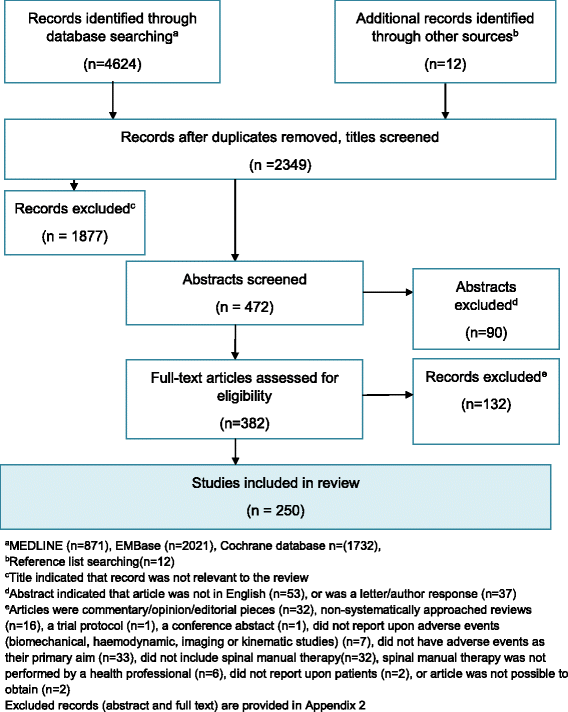What are the risks of manual treatment of the spine? A scoping review for clinicians
- PMID: 29234493
- PMCID: PMC5719861
- DOI: 10.1186/s12998-017-0168-5
What are the risks of manual treatment of the spine? A scoping review for clinicians
Abstract
Background: Communicating to patients the risks of manual treatment to the spine is an important, but challenging element of informed consent. This scoping review aimed to characterise and summarise the available literature on risks and to describe implications for clinical practice and research.
Method: A methodological framework for scoping reviews was followed. Systematic searches were conducted during June 2017. The quantity, nature and sources of literature were described. Findings of included studies were narratively summarised, highlighting key clinical points.
Results: Two hundred and fifty articles were included. Cases of serious adverse events were reported. Observational studies, randomised studies and systematic reviews were also identified, reporting both benign and serious adverse events.Benign adverse events were reported to occur commonly in adults and children. Predictive factors for risk are unclear, but for neck pain patients might include higher levels of neck disability or cervical manipulation. In neck pain patients benign adverse events may result in poorer short term, but not long term outcomes.Serious adverse event incidence estimates ranged from 1 per 2 million manipulations to 13 per 10,000 patients. Cases are reported in adults and children, including spinal or neurological problems as well as cervical arterial strokes. Case-control studies indicate some association, in the under 45 years age group, between manual interventions and cervical arterial stroke, however it is unclear whether this is causal. Elderly patients have no greater risk of traumatic injury compared with visiting a medical practitioner for neuro-musculoskeletal problems, however some underlying conditions may increase risk.
Conclusion: Existing literature indicates that benign adverse events following manual treatments to the spine are common, while serious adverse events are rare. The incidence and causal relationships with serious adverse events are challenging to establish, with gaps in the literature and inherent methodological limitations of studies. Clinicians should ensure that patients are informed of risks during the consent process. Since serious adverse events could result from pre-existing pathologies, assessment for signs or symptoms of these is important. Clinicians may also contribute to furthering understanding by utilising patient safety incident reporting and learning systems where adverse events have occurred.
Keywords: Adverse events; Cervical; Chiropractic; Incident reporting; Manipulation; Manual therapy; Osteopathy; Risks; Spine; Vertebral artery.
Conflict of interest statement
Authors’ information
GS is a chiropractor and is the Director of Research and a Trustee of the Royal College of Chiropractors. She also sits on the General Chiropractic Council of the United Kingdom and has interest in promoting evidence-informed patient safety information to clinicians to improve clinical practice. RF is Chief Executive of The Royal College of Chiropractors, a biologist and an educationalist with interests in professional development and the safety and quality of patient care. He was involved in the development of the Chiropractic Patient Incident Reporting and Learning System. The authors undertook this review in response to many requests received from chiropractors for information about what to communicate to patients regarding the risks of manual treatment to the spine.
Ethics approval and consent to participate
Not applicable.
Consent for publication
Not applicable.
Competing interests
GS is a chiropractor and a trustee of the Royal College of Chiropractors. RF is the Chief Executive of the Royal College of Chiropractors. The Royal College of Chiropractors was involved in the development of the Chiropractic Patient Incident Reporting and Learning System and is a licensor of its use. The Royal College of Chiropractors is a co-funder of Chiropractic and Manual Therapies.
Publisher’s Note
Springer Nature remains neutral with regard to jurisdictional claims in published maps and institutional affiliations.
Figures
Similar articles
-
Identifying Patient Characteristics Associated With the Occurrence of Post Treatment Non-serious Adverse Events After Cervical Spine Manual Therapy Treatment in Patients With Neck Pain.Arch Phys Med Rehabil. 2023 Feb;104(2):277-286. doi: 10.1016/j.apmr.2022.08.007. Epub 2022 Aug 28. Arch Phys Med Rehabil. 2023. PMID: 36037878
-
Adverse Events After Cervical Spinal Manipulation - A Systematic Review and Meta-Analysis of Randomized Clinical Trials.Pain Physician. 2024 May;27(4):185-201. Pain Physician. 2024. PMID: 38805524
-
Safety of chiropractic manipulation of the cervical spine: a prospective national survey.Spine (Phila Pa 1976). 2007 Oct 1;32(21):2375-8; discussion 2379. doi: 10.1097/BRS.0b013e3181557bb1. Spine (Phila Pa 1976). 2007. PMID: 17906581
-
Identifying vascular pathologies or flow limitations: Important aspects in the clinical reasoning process.Musculoskelet Sci Pract. 2021 Jun;53:102343. doi: 10.1016/j.msksp.2021.102343. Epub 2021 Feb 6. Musculoskelet Sci Pract. 2021. PMID: 33610495
-
Reporting of adverse events associated with spinal manipulation in randomised clinical trials: an updated systematic review.BMJ Open. 2023 May 4;13(5):e067526. doi: 10.1136/bmjopen-2022-067526. BMJ Open. 2023. PMID: 37142321 Free PMC article.
Cited by
-
Use of Thrust Cervical Spinal Manipulative Therapy for Complicated Neck Pain: A Cross-Sectional Survey of Asia-Pacific Chiropractors.Cureus. 2022 Dec 12;14(12):e32441. doi: 10.7759/cureus.32441. eCollection 2022 Dec. Cureus. 2022. PMID: 36644078 Free PMC article.
-
Manual therapy interventions in the management of adults with prior cervical spine surgery for degenerative conditions: a scoping review.Chiropr Man Therap. 2022 Mar 7;30(1):13. doi: 10.1186/s12998-022-00422-8. Chiropr Man Therap. 2022. PMID: 35255934 Free PMC article.
-
Cervical epidural hematoma after spinal manipulation therapy: a case report.BMC Musculoskelet Disord. 2019 Oct 22;20(1):461. doi: 10.1186/s12891-019-2871-y. BMC Musculoskelet Disord. 2019. PMID: 31638954 Free PMC article.
-
Clinical Practice Guideline for Best Practice Management of Pediatric Patients by Chiropractors: Results of a Delphi Consensus Process.J Integr Complement Med. 2024 Mar;30(3):216-232. doi: 10.1089/jicm.2023.0010. Epub 2023 Oct 30. J Integr Complement Med. 2024. PMID: 37902954 Free PMC article. Review.
-
Definition and classification for adverse events following spinal and peripheral joint manipulation and mobilization: A scoping review.PLoS One. 2022 Jul 15;17(7):e0270671. doi: 10.1371/journal.pone.0270671. eCollection 2022. PLoS One. 2022. PMID: 35839253 Free PMC article.
References
-
- Health, D.o . In: The Patient’s charter. D.o. Health, editor. London: Her Majesty's Stationary Office; 1991.
Publication types
MeSH terms
LinkOut - more resources
Full Text Sources
Other Literature Sources


